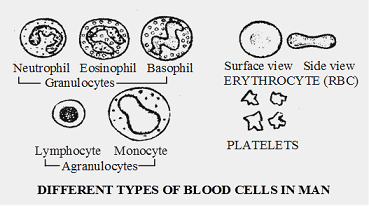Chapter : 3. Transportation
Transportation In Human Being
Transportation In Human Being
In humans, transportation of oxygen O2 nutrients, hormone and other substances to tissue, CO2 to the lungs and waste products to the kidneys is carried out by a well-defined Circulatory System. In lower organisms material is transported by diffusion.
Circulatory System :
It comprises of the heart, blood vessels, blood, lymphatic vessels, lymph, which together serve to transport materials, throughout the body.
Components of the circulatory system in higher animals are -
Blood
Pumping organ- 'Heart'
System of blood vessels for distribution and collection of blood - consisting of arteries, veins and capillaries.

Blood Corpuscles :
I. Red Blood Corpuscles (RBC) or Erythrocytes :
These are minute, circular biconcave discs having no nucleus. They look red due to the presence of red coloured pigment, haemoglobin. Red blood cells have life span about 120 days. They are produced in bone marrow number is 4.5 – 5.5 millon/cu.mm.
Function :
Haemoglobin transports oxygen from lungs to body tissues.
II. WBC or White Blood Cells or Corpuscles :
These are large, nucleated colourless cells and are less numerous than erythrocytes. There are about 5000 W.B.C per mili litre of blood.

WBC are mainly of two Type W.B.C.

III . Blood Platelets :
Platelets are rounded, colourless, biconvex and non-nucleated blood- cells, which help in the coagulation of blood they are called thrombocytes.
In humans, transportation of oxygen O2 nutrients, hormone and other substances to tissue, CO2 to the lungs and waste products to the kidneys is carried out by a well-defined Circulatory System. In lower organisms material is transported by diffusion.
Circulatory System :
It comprises of the heart, blood vessels, blood, lymphatic vessels, lymph, which together serve to transport materials, throughout the body.
Components of the circulatory system in higher animals are -
Blood
Pumping organ- 'Heart'
System of blood vessels for distribution and collection of blood - consisting of arteries, veins and capillaries.

Blood Corpuscles :
I. Red Blood Corpuscles (RBC) or Erythrocytes :
These are minute, circular biconcave discs having no nucleus. They look red due to the presence of red coloured pigment, haemoglobin. Red blood cells have life span about 120 days. They are produced in bone marrow number is 4.5 – 5.5 millon/cu.mm.
Function :
Haemoglobin transports oxygen from lungs to body tissues.
II. WBC or White Blood Cells or Corpuscles :
These are large, nucleated colourless cells and are less numerous than erythrocytes. There are about 5000 W.B.C per mili litre of blood.

WBC are mainly of two Type W.B.C.

III . Blood Platelets :
Platelets are rounded, colourless, biconvex and non-nucleated blood- cells, which help in the coagulation of blood they are called thrombocytes.
Trending Articles & Blogs
- Physics Tutor, Math Tutor Improve Your Child’s Knowledge
- How to Get Maximum Marks in Examination Preparation Strategy by Dr. Mukesh Shrimali
- 5 Important Tips To Personal Development Apply In Your Daily Life
- Breaking the Barriers Between High School and Higher Education
- 14 Vocational courses after class 12th
- Tips to Get Maximum Marks in Physics Examination
- Get Full Marks in Biology Class 12 CBSE
Download Old Sample Papers For Class X & XII
Download Practical Solutions of Chemistry and Physics for Class 12 with Solutions
Recent Questions Asked
- Newton’s laws of motion asked by Dr. Mukesh Shrimali
- Process of nutrition in Amoeba asked by Rajiv Sharma
- Importance of studying physics subject in school after 10th asked by Rajiv
- Refraction Through Prism in Different Medium asked by Kirti Sharma
- Ratio and Proportion Question asked by Education Desk
- Explain all the 12 tenses with example asked by Qwerty
- Refraction Through Prism in Different Medium asked by Seema Shrimali